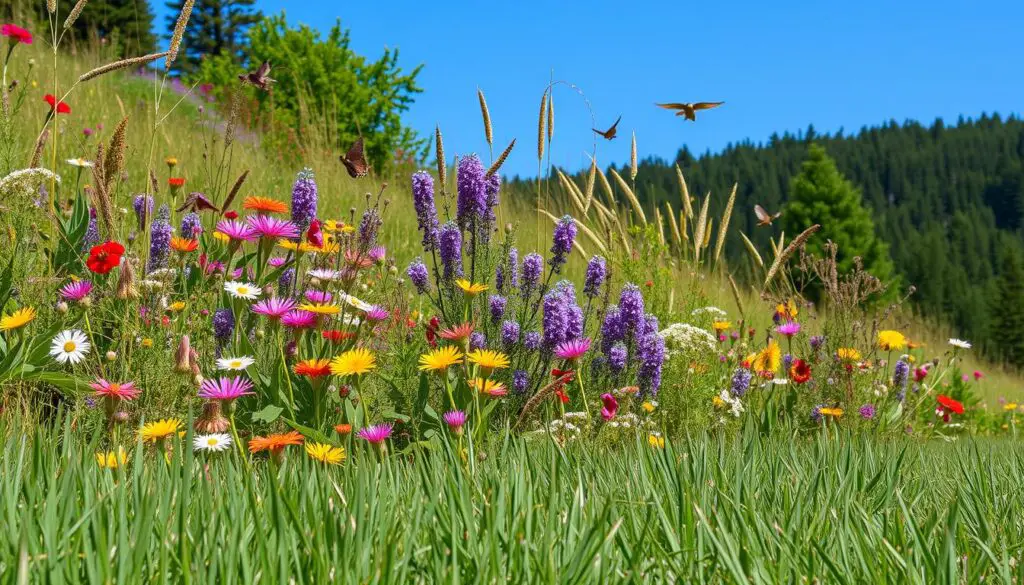The Benefits of Using Native Plants in Lawn Care

Did you know over 40 million acres in the U.S. are covered by non-native lawns? This huge area of green has harmed our local ecosystems. But, there’s a simple way to change your lawn into an eco-friendly space: use native plants.
As a gardener in Utah, I’ve found native plants are amazing. They use less water and boost biodiversity. This article will show how native plants can make your lawn care better and your backyard a paradise.
Key Takeaways
- Native plants need less water and care than non-native ones.
- They help keep local biodiversity alive and offer homes for wildlife.
- Using native plants cuts down on harmful chemicals and gas tools.
- They help the ecosystem by filtering water and fighting climate change.
- Native plants make your yard look great and need little care.
Understanding The Benefits of Native Plants in Lawn Care
Native plants are key to a thriving, sustainable landscape. They are the true residents of their region, chosen by nature to thrive. In Utah, these plants have evolved to endure the harsh environment, showing great resilience and adaptability.
Adaptation to Local Conditions
Native plants fit perfectly with their local climate, soil, and weather. For instance, native buffalo grass has deep roots that reach up to 6 feet deep. This allows it to access water and nutrients better than non-native grasses. This adaptation helps them survive droughts and thrive in tough conditions.
Importance of Biodiversity Preservation
Native plants are vital for preserving local ecosystems. They provide habitats and food for native wildlife. By using native plants in our landscapes, we help keep biodiversity strong, which is crucial for our environment’s health.
As more people want native plants, local nurseries are offering more options. This makes it easier for homeowners to choose eco-friendly plants. By understanding the importance of native plants, we can make choices that benefit our yards and the community.
“Native plants have adapted to local conditions over time, requiring less water, fertilizer, and pesticides, making them environmentally friendly and sustainable choices for landscaping.”
Water Conservation Benefits
Using native plants in your lawn care can save a lot of water. These plants need less water because they are naturally good at surviving without it. They can go without water for a long time and still look great.
Native plants also help with rainwater and attract pollinators. This makes your backyard a better place for both you and the environment. In fact, they can save up to 9 billion gallons of water every day in the U.S. This makes them a smart choice for those who care about water.
Drought-Tolerant and Water-Wise
Native plants have deep roots, unlike regular grass. Their roots can go as deep as 15 feet. This lets them get water from deep down, so they don’t need to be watered as often.
- Xeriscaping, using plants that don’t need much water, can cut water use by half.
- Adding 2 to 3 inches of mulch around plants keeps the soil moist and stops water from evaporating.
- Keeping grass a bit taller, around 2.5 to 3.5 inches, helps keep moisture in and stops water from evaporating.
By using these water-saving tips and choosing drought-tolerant plants, you can use less water. Your outdoor space will still look great and be healthy.
“Native plants can save up to 9 billion gallons of water per day in the U.S.”
As worries about water conservation grow, so does the need for water-wise landscaping with native plants. By choosing wisely for your lawn, you help the planet. You also get a beautiful and strong outdoor area.
Low Maintenance Requirements
Native plants are a great choice for your lawn because they need less care. They fight off pests and diseases on their own, so you don’t need to use a lot of fertilizers and pesticides. This saves you time and helps the environment, making your lawn care more eco-friendly.
Reduced Need for Fertilizers and Pesticides
Native plants fit well in your local soil and climate, needing less help to grow. By choosing them, you avoid the hassle and harm of using lots of fertilizers and pesticides. This lets you enjoy your yard more, without spending hours on lawn care.
Less Work and Ecosystem Preservation
Traditional lawns need a lot of work, like mowing and watering. Native plants, on the other hand, are better at handling drought and need less water. This means less work for you and helps keep your local ecosystem healthy. By using native plants, you create a beautiful, easy-to-care-for space that supports local wildlife.
“Gardening with native plants is a way to create a resilient, low-maintenance landscape that supports local wildlife and promotes a healthy, sustainable ecosystem.”

Resilience and Longevity
The lasting beauty of Utah’s drought-resistant plants and climate-adapted plants shows their special qualities. These hardy native plants have learned to handle Utah’s harsh weather. They survive the hot sun, strong winds, and cold winters, making your garden beautiful for years.
Using low-maintenance landscaping with native plants is smart. They can handle Utah’s climate well. Their deep roots and special leaves help them save water, even when it’s dry. This means you don’t have to water them as much and they’re less likely to die in bad weather.
“Native habitat restoration could provide one-third of the mitigation needed to stabilize global warming by 2030. Over its lifetime, a single tree can sequester about 1 ton of carbon dioxide.” – Sam, author here
Native plants also fight off pests and diseases better, which means you use fewer harmful chemicals. This is good for your garden and the environment. By choosing climate-adapted plants and hardy native plants, you’ll have a beautiful, easy-to-care-for garden that lasts a long time.
Attracting Wildlife to Your Yard
Creating a wildlife-friendly yard is a great way to help local nature and make your space lively. By using native plants, you can draw in birds, butterflies, bees, and more. They get food and a safe place to live.
Native plants fit well with your local weather and soil. They’re perfect for a wildlife-friendly garden. These plants give vital food and shelter to insects, which helps the whole food chain.
A well-designed pollinator garden attracts bees, butterflies, and hummingbirds. Choose native flowers that bloom at different times. This way, you offer food all year for these important creatures.
For birds, add native trees, shrubs, and plants. They give birds shelter, places to nest, and food. This brings color and songs to your yard and helps your local ecosystem.

“By creating a certified wildlife habitat, you’re not just beautifying your yard – you’re making a meaningful contribution to the health and well-being of local ecosystems.”
Turning your lawn or garden into a wildlife home is rewarding. It helps the natural world. Whether you plant a few native species or create a big wildlife-friendly landscape, every bit helps our environment.
Glover’s Favorite Native Plants
At Glover, we’ve picked some top native and low-water plants for Utah’s climate. These plants make outdoor spaces beautiful and help local ecosystems. They provide important resources for pollinators and wildlife.
Perennial: Russian Sage
The Russian Sage has long-lasting lavender-blue blooms and silver-green leaves. It’s a drought-tolerant perennial that attracts bees and butterflies. This hardy plant needs little care, making it perfect for low-water gardens.
Shrub: Sumac
The Sumac shrub comes in many sizes, from small ‘Tiger Eyes’ to tall ‘Grow-a-Row’. It’s a tough, drought-tolerant plant with vibrant fall colors and winter berries. These berries feed birds all year.
Tree: Crabapple
The crabapple tree has stunning spring blossoms and lasting winter fruit. It’s a native favorite that adds beauty and ecological value. Crabapples need little water and feed many pollinators and wildlife.
These plants from Glover are great for Utah’s climate. They’re low-water, pollinator-friendly, and fit Utah’s unique growing conditions. Adding them to your yard creates a beautiful, sustainable space.
Addressing Common Concerns
Native plants offer many benefits for your landscape. Yet, you might have some concerns. These include finding drought-tolerant plants and creating a beautiful xeriscape design. Understanding these aspects can help you make a sustainable and stunning yard.
Drought-Tolerant Plants
One big worry is if native plants can handle dry weather. But, there are many drought-tolerant native plants that need little water. These plants have adapted to local weather, making them perfect for dry times.
With the right xeriscape design and water-efficient irrigation, your yard can be beautiful and low-maintenance. It won’t need as much care as a traditional lawn.
Sprinkler Systems
Another worry is changing sprinkler systems for native plants. Some tweaks might be needed, but it’s worth it. A good irrigation system for your non-invasive native plants saves water and helps them grow well.
Aesthetic Concerns
Some people think native plants won’t look good. But, with the right xeriscape design and plant choices, you can make a stunning landscape. Native plants come in many colors, textures, and shapes. This lets you create a beautiful outdoor space that matches your style.

“Proper landscaping choices can decrease energy and stormwater costs, eliminate irrigation system needs, and enhance site livability.”
By tackling these concerns and understanding native plants, you can turn your yard into a green oasis. It will save resources, look great, and add value to your home.
Native Plants Lawn Care
Your yard is more than just land. It’s a canvas for native plants to bring color and texture. Using these plants makes your landscape greener, low-maintenance, and eco-friendly.
Native plant landscaping offers many benefits. These plants need less water and maintenance than others. They help your yard use less water and care, supporting local ecosystems.
Native plants are great for saving water. Their deep roots soak up rain, stopping runoff and cutting down on watering. This saves money and helps your watershed.
Also, using native plants means less fertilizers and pesticides. They grow well without these harmful chemicals. This protects wildlife and the ecosystem.
Exploring low-water gardening with native plants opens up new possibilities. You can have everything from wildflowers to trees. There’s a native plant for every part of your yard, turning it into a lush oasis.

Start making your yard greener by using native plants. Your environment, wildlife, and wallet will appreciate it.
Sustainable Landscaping Design Tips
Designing a drought-tolerant landscape starts with zoning your lawn and flower beds. Group plants by their watering needs to save water. Choose native plants that need little care and water.
Design Considerations
A good irrigation system is key to sustainable landscaping. Use drip irrigation to save up to 90% of water. Rain barrels and rain gardens also help save water by capturing rain.
Plant Selection Guidelines
Choose drought-tolerant and native plants for your landscape. They need less water and care. A mix of native perennials, shrubs, and trees supports local wildlife.
Irrigation System Efficiency
Make your irrigation system efficient to save water. Use smart controllers and moisture sensors. Regular maintenance prevents waste and keeps plants hydrated.
FAQ
What are the benefits of using native plants in my lawn care?
How do native plants adapt to the local conditions in Utah?
Why is preserving biodiversity important when gardening?
How do native plants help with water conservation?
What are the benefits of low-maintenance native plants?
How do native plants provide long-term resilience and longevity in my landscape?
What types of wildlife will native plants attract to my yard?
What are some of Glover’s favorite native and low-water plants for Utah?
How can I overcome common concerns about using native plants in my landscape?
Source Links
- https://www.lawnstarter.com/blog/landscaping/benefits-native-plants/
- https://lawnlove.com/blog/reasons-to-grow-native-plants/
- https://www.audubon.org/content/why-native-plants-matter
- https://lawnlove.com/blog/what-is-native-plant/
- https://tillydesign.com/blog/understanding-native-plants/
- https://www.mcdonaldgardencenter.com/blog/natives-vs-nativars-bridging-gap-between-native-plants-and-modern-gardening
- https://www.the71percent.org/lawn-care-practices-that-promote-water-conservation/
- https://content.gardenforwildlife.com/learn/native-plants-vs-lawns-a-greener-choice-for-your-yard
- https://www.monarchgard.com/thedeepmiddle/why-lawn-is-easier-to-maintain-than-a-natural-garden
- https://www.finegardening.com/article/low-maintenance-alternatives-to-lawns
- https://wildones.org/sustaining-health-through-native-plants-and-biodiversity/
- https://craineprojects.ca/building-resilient-gardens-lawns-and-backyards-that-withstand-any-weather-change/
- https://baynature.org/article/gardening-for-wildlife-with-native-plants/
- https://stephanieschuttler.com/upgrade-your-yard-for-wildlife-by-letting-it-go/
- https://homesteadandchill.com/garden-certified-wildlife-habitat/
- https://glovernursery.com/garden-with-native-plants/
- https://redbuttegarden.org/local-retail-partners/
- https://grownative.org/learn/native-garden-installation-toolkit/
- https://www.kellerlawnandlandscape.com/post/10-common-residential-landscaping-problems-and-how-to-solve-them
- https://npsnj.org/wp-content/uploads/2023/01/BBP_Going_Native_Northern_NJ_Edition_2022.pdf
- https://www.jerseyyards.org/jersey-friendly-plants/native-plants/
- https://www.sunset.com/home-garden/landscaping/native-plant-lawn-guide
- https://calrecycle.ca.gov/organics/landscaping/
- https://pacificoutdoorliving.com/blog/sustainable-yard/
- https://www.spyker.com/blog/sustainable-landscape-design-using-native-plants-and-more/

